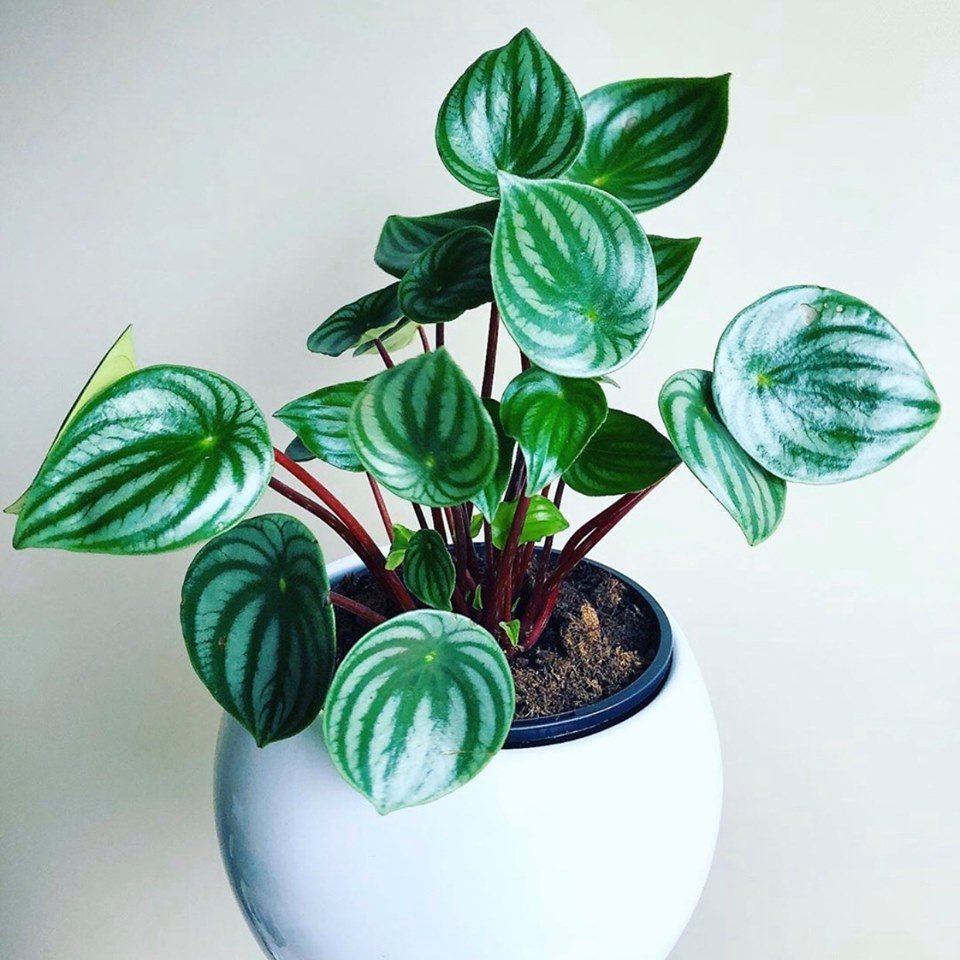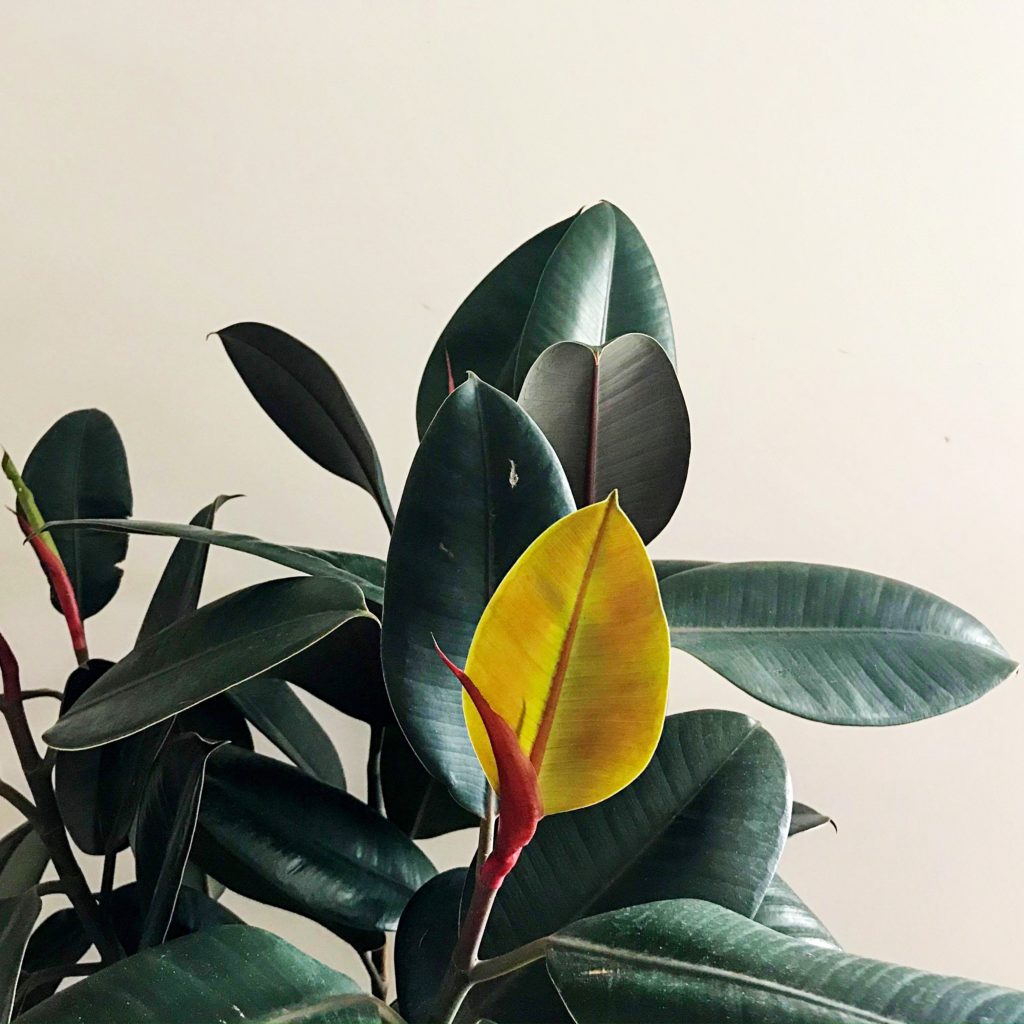Pilea Argyreia a.k.a Watermelon Peperomia
Watermelon Peperomia is a favourited house plant. Its leaves resemble the rind of a watermelon which is where the nickname ‘Watermelon’ Peperomia comes from. These plants are a flowering plant that is native to South America. The flowers look more like spikes than they do flowers. They have a reddy pink stalk with flowers that are a greenish, whitey cream colour.
Not only is this plant a must have in your plant collection, the Watermelon Peperomia is super easy to propagate. It can be propagated by a stem or leaf cutting. You can read more about propagating house plants here.

Watermelon Peperomia Quick Overview
| Full Size | Up to 12 inches |
| Light | Bright indirect |
| Temperature | 65-80°F (18-26˚C) |
| Humidity | 40%-50% |
| Cost | $$ |
| Care Level | Medium |
| Toxicity | Non toxic |
Size
The mature size of a Watermelon Peperomia can be up to 12 inches tall and 8 inches wide. These types of plants have a compact growth habit and will grow small and bushy. When grown in the right living conditions, this plant can be quite fast growing and reproduce quickly. The flowers of a Watermelon Peperomia grow to about 3 inches long.
Watermelon Peperomia Light Requirements
Watermelon Peperomia will grow best when in medium to bright indirect lighting. You should avoid the direct sunlight as this can burn the foliage. This plant can survive in lower light conditions however, it will become leggy and the foliage will grow smaller. Providing your plant with filtered indirect lighting will help to keep your Watermelon Peperomia happy.
The foliage of your Watermelon Peperomia will grow as a darker green colour and lose its silver variegation as a sign of not enough light. If this plant receives too much bright light, the leaves will curl and the colours and patterns on the foliage will fade. This can be resolved by changing the position of your plant to somewhere that better suits its light requirements.
Adding a blind or curtain to your window will help to defuse the harsh sunlight to avoid burning the plants foliage. Alternatively, if you can’t seem to find that perfect spot in your home, you can always use grow lights. Just like direct sunlight, if your plant is sitting too close to the grow lights, they will burn the foliage. Keeping a safe distance of at least 60cm between your plant and the light will avoid any trouble.
Temperature
The ideal temperature for growing Watermelon Peperomia is between 65ºF-80ºF (18ºC-26ºC). Since this plant originates from a tropical climate, it loves being kept in warmer temperatures. If the temperature drops below 60ºF (15ºC), your Watermelon Peperomia may get wilted leaves. During the cooler months, you should move your plant to a warmer spot in your home.
Humidity
Watermelon Peperomia will grow best when kept in a moderate (40%-50%) humidity environment. Keeping your plant away from vents and drafty windows will help to stop the air from drying out around the plant. When kept in a spot with high humidity, the foliage and stems of the plant are prone to fungal infections. If your Watermelon Peperomia is kept in a spot with low humidity, the leaves will start to curl and drop off. This can lead to possible plant death.
If your plant is housed in a spot where it’s low in humidity, there are a few thing you can do that can help bump up the humidity in your home. The things you can try are:
- Misting your plants
- Pebble trays
- Grouping plants together
- Humidifier
You can read more about increasing humidity in your home here.
Watermelon Peperomia Watering Requirements
Watermelon Peperomia like to be moderately watered. This plant can be quite sensitive when it comes to over-watering and under-watering. Watermelon Peperomia like to be kept in somewhat moist soil. You should check the top 1-2 inches of soil with your finger to feel if the soil is still moist. If the soil is dry, you can give your plant a drink. A sign that your Watermelon Peperomia desperately needs water is when the leaves start to droop and feel thin.
Although Watermelon Peperomia like a somewhat moist soil, you need to try and avoid over-watering. Excess water can cause the soil to become waterlogged and this can cause root-rot. When the roots start rotting, they don’t allow the plant to take in any water. This can then cause pest problems, fungus issues and plant death. Signs that you have over-watered your Watermelon Peperomia are wilting and yellowing leaves, brown and mushy roots and brown spots on the leaves.
Fertilizing requirements
You should fertilize your Watermelon Peperomia monthly during Spring and Summer. You can cut down on fertilizer during the cooler months (Autumn and Winter) when the plants growth has slowed. Applying fertilizer to plants when they’re not actively growing and using nutrients in the soil can cause root burn and salt build up. Fertilizing your plants when they’re actively growing helps to give them the essential nutrients they need to promote new and healthy growth.
The best fertilizer to use for Watermelon Peperomia would be a balanced all purpose fertilizer diluted to half strength. You should use a fertilizer that contains equal parts of Potassium, Iron and Nitrogen. These elements will help to promote and maintain healthy growth. You can also add things like leaf and bark matter, peat and organic manure to the soil to create an organic fertilizer.
These plants are light feeders so when it comes to fertilizing, you need to be cautious of over-fertilizing. A sign that you may have over-fertilized your Watermelon Peperomia is if the plant is becoming long and leggy. If you think you have over-fertilized your plant, you can either change the soil or flush out the fertilizer. You will notice a change in the water colour when the fertilizer has been rinsed out.
For more information on fertilizing houseplants click here.
Soil Requirements
Watermelon Peperomia like to be kept in a rich, well draining soil. To achieve a well draining soil, you can add things like orchid bark, peat moss and perlite to help create better drainage and aeration. Airflow is important as it allows the plant roots to breath and not having enough oxygen to the roots can cause then to rot. When planting your Watermelon Peperomia, you need to be careful that you don’t use a pot that is too big. This plant liked to be slightly root bound.
You can add other ingredients like coco coir, mulch chunks and coconut husk to the soil to help restrain moisture. However, using equal parts peat moss and perlite makes an ideal mix for this plant. The plant will wrap its roots around these materials and absorb the moisture. Watermelon Peperomia like to be kept somewhat moist so it’s important to use materials that will help hold moisture but won’t make the soil soggy.
Diseases & Pests
The common pests you may encounter on your Watermelon Peperomia are Whitefly, Spider Mites, Mealybugs, Fungus Gnats, Aphids and Thrips. The most common disease you may encounter is Root-rot. For more information on identifying and treating common houseplant pests click here.
The best thing you can do when it comes to pests on houseplants is to try and avoid any pest infestations from starting. There are a few things you can do that will assist in preventing any pest infestations and these things are:
- Checking new plants for pests or isolating new plants for up to a week.
- Check your plants every few days for pests.
- Trim off any dead or dying leaves.
- Wipe down leaves if you notice them getting dusty.
- Keeping your plants healthy. A healthy plant will be able to handle an infestation better than those that aren’t as happy.
- Isolate any plants that have pests.
Following this will assist in keeping pests away as well as catch them early on before any severe infestations are able to start. Keeping plants healthy and in the correct living environments can help to deter any pests from invading your plants.
Toxicity
Watermelon Peperomia are considered to be non toxic to both humans and pets.



